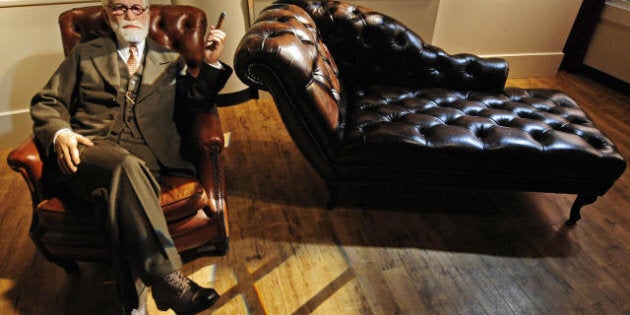
I have had the opportunity to experience many types of therapy for my mental illness. I have seen psychiatrists, a spiritual care provider, I have tried several medications and am happily doing well on one, and I have seen a psychoanalyst. I wasn't looking for one. Sitting down with a replica of Freud wasn't something I relished. But, I was unwell, I needed help. One of the biggest problems in mental health care is the lack of professionals. And in Ontario, only psychiatrists are covered by our health insurance. Almost all other therapists charge a professional fee. I found my new therapist on a website. He was able to fit me in and as I was tanking, I took a chance.
I had an image of a psychoanalyst in my head. Probably similar to yours. Patient lying on couch, facing a wall. You can imagine a thought bubble over her head overflowing with words; "Yada, yada, yada." Then, behind her, the analyst. Yes, I picture him with the ubiquitous pipe between his teeth, smoke rising gently upward, a pad of paper in his lap and a constant "aha, aha," after every comment I make all the while he is thinking, "I wonder what's for dinner?"
My analyst, Dr. Stephen Fowler of Streetsville, Ontario, is a Freudian analyst. Yes, it is true; there is a couch for you. It was dark brown leather with a slip of paper on which to rest my head. It faces a "shades of grey" jagged brick wall. He sits behind the couch and you talk. On my first visit I told him that I was uncomfortable lying down on the couch and telling my thoughts to a wall. With the recurrence of my anxiety and depression, I had been talking to walls, trees, anything for months. The last thing I needed was to talk to a wall in his office. He kindly allowed me to sit in a chair and face him.
I wanted to make the best use of my time with him so I tried on several occasions to lie down on the couch, look at the wall and just talk. I am grateful that this analyst talks as well. I didn't want to be yammering away with no feedback. That would never work for me. Well, talking toward the wall would go well for a bit and then when something important (in my mind) came up I would jump up out off the couch and sit in the chair. He would get up from behind me and sit in his chair. And I would return to the couch, and he to his chair behind me. It became a dance after a while.
Lying on a couch with a man sitting behind me is uncomfortable to say the least. It provokes anxiety. It takes time to get comfortable. But it was worth the time and the work. This is the explanation Dr. Fowler gave me to better understand the process. It is like being at a drive-in movie. One is in the front seat, one in the back and you are both watching the movie together and discussing it. In therapy, the patient is lying down, in the front seat, the therapist is sitting in the back seat and you, the patient, are projecting your story onto this wall, this blank screen, and he visualizes the story you are telling and then you discuss it.
He helped me de-tangle emotions that are very close to each other. Anger, hurt and frustration-primal emotions. He helped me to recognize and name the emotion I was experiencing so that I could respond appropriately. Think of young children. They get angry, but they aren't angry, they are frustrated. Or they say they are angry, and they are hurt. We teach them to identify feelings. Mine got mixed up. Mixed-up feelings lead to wrong responses.
Go into this therapy with an open mind, with a positive attitude. Decide at the very beginning that this is going to work because you want to participate in your healing. Psychoanalysis depends a lot on talking freely -- a stream of consciousness. Wilhelm von Humboldt said in the 18th century, "Language is, as it were, the external manifestation of the minds of the peoples. Their language is their soul, and their soul is their language."
We are our stories.Think of this as telling your story. The moment you find yourself editing a thought is the moment before revelation. You are about to discover something about yourself; and it might not be pretty. But this is the place to explore. This is a safe place to express your fears and feelings, your failures and your successes. This is the place to relive past painful experiences and find new meaning for them and put them to bed. This is a place for you to forgive yourself for your failings. Almost religious.
I also learned to identify my stressors and develop strategies to reduce their impact on me. I have fewer episodes of depression, now. I developed more confidence in my decision making and in myself when I implemented the lessons learned.
Psychoanalysis requires multiple visits per week to really make breakthroughs. I was just developing independence and did not want to become dependent again, so we came to a compromise that worked well.
It is not as difficult as one might think to know when it is time to move on. A good therapist will let you know if you might be leaving too soon, but a good therapist will let you go and leave the door open.
I have been blessed with access to wonderful therapists, all with different specialties who helped me at those particular times in my life. Just as I have learned that different therapies help at different times in my life, different people respond differently to different therapies. Don't give up. Fight for your mental health.
To learn more about different therapies for mental illness here is a link to my podcast.
